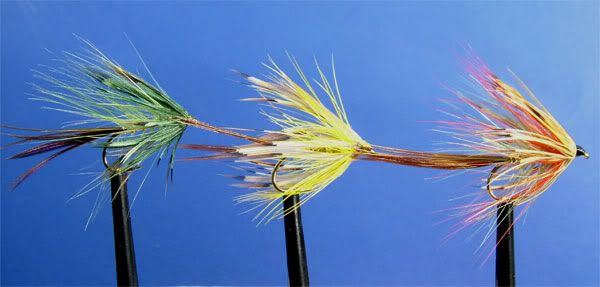scotfly wrote:Definitely function. They're designed for a big wave on the Irish loughs.
I've never fished on the Irish loughs or fished with this style of fly, so cannot comment from personal experience, but they are reputed to be a "must" for Irish trout at Mayfly time.
The style has been around for a long time, so I see no reason why they won't be around in ten years time.
Hi Scotfly,
The reason I mentioned the internet:
The evolution of fishing fly patterns fascinates me. Who first thought of them, how did some of these often fantastic creations come about, how long have they been around, the reasons for regional variations, etc.
Of course we can never really answer these questions as often the answers will lie in 'folk history', some patterns written down a hundred years or more ago but probably tied and passed down by word of mouth for many, many years before that. But, it is fun to speculate.

I suspect the process has been one largely of trial and error, both at the tying bench and at the waterside. It probably to some extent mirrored the Darwinian evolution of the insects they sought to suggest: survival of the fittest, or at least survival of what worked then modified then tied again and tested.
But there is no single answer, no 'right' answer to designing a fly that catches a fish.
Otter then says:
These wets are designed to be pulled (stripped back) on the Irish loughs . These types have as Scotfly says have been around for a 100 years or more and as long as there are trout in the loughs they will be tied. Whilst many irish lough fishermen have incorporated english resevoir tactics into their repetoire the traditional wet fly fishing still prevails.
The thing you have to realise is that these are big lakes and with wild trout that are spread out all over the shallow's and often into the deeps you have to cover a lot of ground to find feeding fish.
And from the website Otter linked to:
This causes a big wake and lots of commotion at the water surface. (from the copy attached to the Reverse Mayfly)
Fair enough, but I most likely have flies in my reservoir box designed to do this but that look very different! Because of course, there is 'more than one way to skin a cat'! There is no definitive 'right' way to deceive a trout.
And this is when I reckon it gets really interesting, because this is when people get involved, and when people get involved we start to tell stories, to ourselves as well as to others, and we gather together in small bands with the like minded, and we form hierarchies, loyalties and prejudices, and our heroes and villains - in short, we form communities, and cultures.
One of the reasons for the tremendous number of fly patterns available, must largely be due to the fact that most of the experimentation and design went on in geographically distinct regions. (There is no single pattern that is guaranteed to represent the mayfly. But in one region one was found to be successful and went off in one tangent, in another it was another, and so the divergence began.) Of course there was some cross-fertilisation (travel, days of Empire etc) but the point remains that there were / are distinct 'bloodlines' of fly design.
But the internet has blown all that apart. Look at this forum? For us, the hoi poloi, the great unwashed (well me anyway!) there is now no need for geographic isolation. I can take my influences from the best fly tyers in the world! I can even talk to them!

But what are the consequences of that? Will it lead to homogenisation? That the strongest characters will convince that their pattern is the definitive way? Will the local traditions survive? Or is it just another stage in the Darwinian evolution of fly design - will we really find the definitive answer for the best way to fool a trout into thinking it is the real fly?
(If you need any proof of the way mass communication can threaten local cultures, look at how jealously the French guard theirs from the 'Americanisation' by the mass media!)
Anyway, that's why I mentioned the internet - the 'ten years' was just plucked out of the air.

Just a bit of fun speculation.

Glassjet
ps - Otter - thanks for the link - beautiful flies. Never had a go at tying like that, but I will do - and test it on my reservoir...





